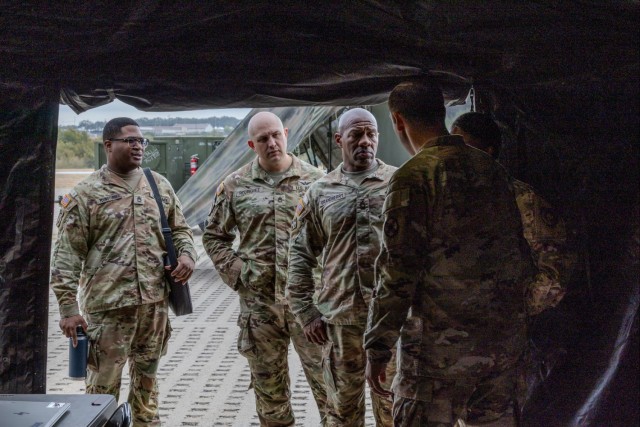FORT HOOD, TEXAS —U.S. Army Soldiers from the 300th Sustainment Brigade, 4th Expeditionary Sustainment Command, U.S. Army Reserve integrated with the 13th Armored Corps Sustainment Command, III Armored Corps during a staff exercise from October 20, 2025, through October 26, 2025.
300th Sustainment Brigade’s integration comes ahead of a scheduled multi-component pilot program, which aims to increase and improve overall readiness and lethality of Army units through unit integration across Army service components. The pilot program culminates with Operational Sentinel Justice, which tests, validates, and stresses the effectiveness of the multi-component sustainment enterprise.
The United States Army is composed of three components: COMPO 1 - the regular Army; COMPO-2 - the Army National Guard; and COMPO 3 - the Army Reserves. The upcoming pilot program aims to enhance force structure and working relationships, integrating components from the active and reserve forces for a unique training opportunity.
“The Army total force is built upon the principle of combining Army [components],” said Lt. Col. Renee Taylor, support operations officer with 300th SB. “It’s this same principle that increases and improves overall readiness through fostering better integration across components by training side-by-side.”
Soldiers on the battlefield always need bullets, beans, and fuel, Taylor said. While sustainment’s core mission set remains the same across Army components, this program aims to combine and integrate units within the Army force structure to improve interoperability and ensure ongoing sustainment operations.
“By attaching reserve sustainment brigades to active duty corps sustainment commands, the program creates a unified sustainment enterprise,” said Cpt. Colby Budd, lead planner for the multi-component integration, 13ACSC, III Corps. “This integration ensures that sustainment operations are seamless and effective across forces, reducing the risks associated with ad hoc assignments during active conflict”.
The establishment of cross-component leadership positions and joint training plans fosters collaboration and mutual understanding between Army force structures, Budd said. Exercise results will inform and shape future doctrine, policies, and organizational structures.
The pilot program seeks to inform how sustainment operations can be conducted in the future, emphasizing readiness and integration as a key tenant of modernization to support the Army’s evolving sustainment and operational needs.
“The goal is for units in the pilot program to execute training using a total Army concept, which would result in no difference in capability between [Active Duty and Army Reserve] and allow [Army Reserve] sustainment brigades to deploy without post-mobility training,” Budd said.
The 300th SB was invited to participate in the 13th ACSC Staff Exercise as an early opportunity to increase partnership and coordination between the unit staffs. Working together in a staff exercise allowed Soldiers from the 300th SB and 13th ACSC to integrate their efforts across essential staff sections, including human resources, communications and automations, and sustainment operations.
“We don’t get these opportunities often, but for us to be in the first pilot and to be nested is a tremendous opportunity and really helps us get ready for the future fight,” said Col. Anthony Calingo, commander of the 300th SB. “We have to all work together, especially in the logistics and sustainment community.”
The partnership between the 13th ACSC and the 300th SB is structured to foster collaboration, and interoperability between both units through integrated training plans, cross-component leadership, resource sharing, and joint exercises.






Social Sharing